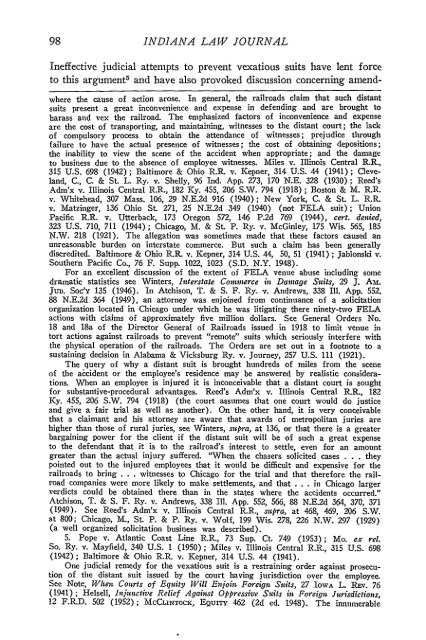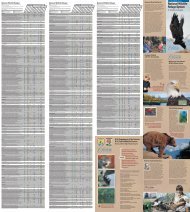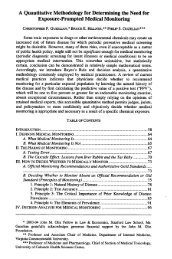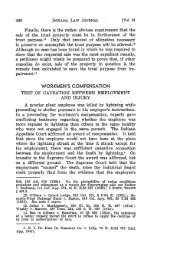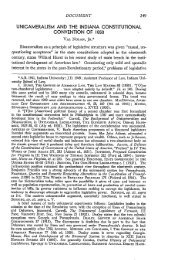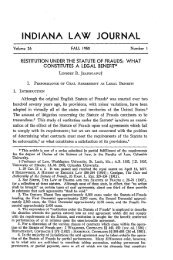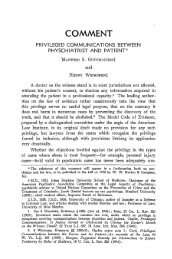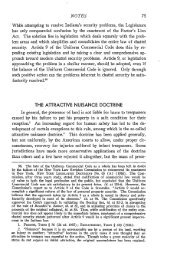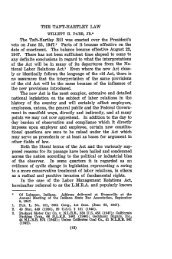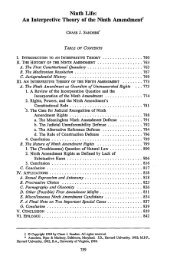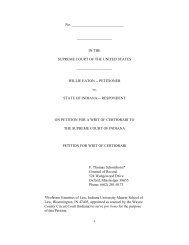fela venue abuse: necessity for congressional amendment
fela venue abuse: necessity for congressional amendment
fela venue abuse: necessity for congressional amendment
Create successful ePaper yourself
Turn your PDF publications into a flip-book with our unique Google optimized e-Paper software.
INDIANA LAW JOURNAL<br />
Ineffective judicial attempts to prevent vexatious suits have lent <strong>for</strong>ce<br />
to this argument 5 and have also provoked discussion concerning amend-<br />
where the cause of action arose. In general, the railroads claim that such distant<br />
suits present a great inconvenience and expense in defending and are brought to<br />
harass and vex the railroad. The emphasized factors of inconvenience and expense<br />
are the cost of transporting, and maintaining, witnesses to the distant court; the lack<br />
of compulsory process to obtain the attendance of witnesses; prejudice through<br />
failure to have the actual presence of witnesses; the cost of obtaining depositions;<br />
the inability to view the scene of the accident when appropriate; and the damage<br />
to business due to the absence of employee witnesses. Miles v. Illinois Central R.R.,<br />
315 U.S. 698 (1942); Baltimore & Ohio R.R. v. Kepner, 314 U.S. 44 (1941); Cleveland,<br />
C., C. & St. L. Ry. v. Shelly, 96 Ind. App. 273, 170 N.E. 328 (1930); Reed's<br />
Adm'x v. Illinois Central R.R., 182 Ky. 455, 206 S.W. 794 (1918); Boston & M. R.R.<br />
v. Whitehead, 307 Mass. 106, 29 N.E.2d 916 (1940); New York, C. & St. L. R.R.<br />
v. Matzinger, 136 Ohio St. 271, 25 N.E.2d 349 (1940) (not FELA suit); Union<br />
Pacific R.R. v. Utterback, 173 Oregon 572, 146 P.2d 769 (1944), cert. denied,<br />
323 U.S. 710, 711 (1944); Chicago, M. & St. P. Ry. v. McGinley, 175 Wis. 565, 185<br />
N.W. 218 (1921). The allegation was sometimes made that these factors caused an<br />
unreasonable burden on interstate commerce. But such a claim has been generally<br />
discredited. Baltimore & Ohio R.R. v. Kepner, 314 U.S. 44, 50, 51 (1941) ; Jablonski v.<br />
Southern Pacific Co., 76 F. Supp. 1022, 1023 (S.D. N.Y. 1948).<br />
For an excellent discussion of the extent of FELA <strong>venue</strong> <strong>abuse</strong> including some<br />
dramatic statistics see Winters, Interstate Commerce in Damage Suits, 29 J. AM.<br />
Jun. Soc'y 135 (1946). In Atchison, T. & S. F. Ry. v. Andrews, 338 Ill. App. 552.<br />
88 N.E.2d 364 (1949), an attorney was enjoined from continuance of a solicitation<br />
organization located in Chicago under which he was litigating there ninety-two FELA<br />
actions with claims of approximately five million dollars. See General Orders No.<br />
18 and 18a of the Director General of Railroads issued in 1918 to limit <strong>venue</strong> in<br />
tort actions against railroads to prevent "remote" suits which seriously interfere with<br />
the physical operation of the railroads. The Orders are set out in a footnote to a<br />
sustaining decision in Alabama & Vicksburg Ry. v. Journey, 257 U.S. 111 (1921).<br />
The query of why a distant suit is brought hundreds of miles from the scene<br />
of the azcident or the employee's residence may be answered by realistic considerations.<br />
When an employee is injured it is inconceivable that a distant court is sought<br />
<strong>for</strong> substantive-procedural advantages. Reed's Adm'x v. Illinois Central R.R., 182<br />
Ky. 455, 206 S.W. 794 (1918) (the court assumes that one court would do justice<br />
and give a fair trial as well as another). On the other hand, it is very conceivable<br />
that a claimant and his attorney are aware that awards of metropolitan juries are<br />
higher than those of rural juries, see Winters, supra, at 136, or that there is a greater<br />
bargaining power <strong>for</strong> the client if the distant suit will be of such a great expense<br />
to the defendant that it is to the railroad's interest to settle, even <strong>for</strong> an amount<br />
greater than the actual injury suffered. "When the chasers solicited cases . . . they<br />
pointed out to the injured employees that it would be difficult and expensive <strong>for</strong> the<br />
railroads to bring . . . witnesses to Chicago <strong>for</strong> the trial and that there<strong>for</strong>e the railroad<br />
companies were more likely to make settlements, and that . . . in Chicago larger<br />
verdicts could be obtained there than in the states where the accidents occurred."<br />
Atchison, T. & S. F. Ry. v. Andrews, 338 Ill. App. 552, 566, 88 N.E.2d 364, 370, 371<br />
(1949). See Reed's Adm'x v. Illinois Central R.R., supra, at 468, 469, 206 S.W.<br />
at 800; Chicago, M., St. P. & P. Ry. v. Wolf, 199 Wis. 278, 226 N.W. 297 (1929)<br />
(a well organized solicitation business was described).<br />
5. Pope v. Atlantic Coast Line R.R., 73 Sup. Ct. 749 (1953) ; Mo. ex rel.<br />
So. Ry. v. Mayfield, 340 U.S. 1 (1950); Miles v. Illinois Central R.R., 315 U.S. 698<br />
(1942); Baltimore & Ohio R.R. v. Kepner, 314 U.S. 44 (1941).<br />
One judicial remedy <strong>for</strong> the vexatious suit is a restraining order against prosecution<br />
of the distant suit issued by the court having jurisdiction over the employee.<br />
See Note, When Courts of Equity Will Enjoin Foreign Suits, 27 IOWA L. REv. 76<br />
(1941); Helsell, Injunctive Relief Against Oppressive Suits in Foreign Jurisdictions,<br />
12 F.R.D. 502 (1952); McCLINTOCK, EQuITY 462 (2d ed. 1948). The innumerable


